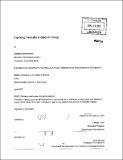| dc.contributor.advisor | J. Meejin Yoon. | en_US |
| dc.contributor.author | Jakimovska, Gordana | en_US |
| dc.contributor.other | Massachusetts Institute of Technology. Dept. of Architecture. | en_US |
| dc.date.accessioned | 2007-10-22T17:34:43Z | |
| dc.date.available | 2007-10-22T17:34:43Z | |
| dc.date.copyright | 2007 | en_US |
| dc.date.issued | 2007 | en_US |
| dc.identifier.uri | http://hdl.handle.net/1721.1/39315 | |
| dc.description | Thesis (S.M.)--Massachusetts Institute of Technology, Dept. of Architecture, 2007. | en_US |
| dc.description | Includes bibliographical references (p. 47). | en_US |
| dc.description.abstract | The Olympic Games, World Cup and similar events often serve as catalysts for the regeneration of urban areas and for the construction of new infrastructure and sport facilities. These sport venues attract a variety of social and cultural activities; consequently, such venues, particularly the stadiums, have regained their importance as city icons. In the past, Olympic Games have fostered the creation of "white elephants"- large numbers of elaborate stadiums and infrastructures, whose full capacity would not be utilized after the events and whose long-term maintenance costs were unjustified. Therefore, when planning sport venues, the post-event use of the facilities is of significant importance. This thesis analyzes the stadium typology and existing case studies, in order to explore new spatial organizations that allow greater flexibility in stadium's form and function. This flexibility support different scenarios of the stadium life. In the specific case of the Olympic Stadium for London 2012 Games, from 80.000 seats Olympic stadium to 35.000 seats athletic stadium; to soccer stadium; to various multifunction venues that can play an important role in the economic, social and cultural improvement of the specific urban area. | en_US |
| dc.description.statementofresponsibility | by Gordana Jakimovska. | en_US |
| dc.format.extent | 47 p. | en_US |
| dc.language.iso | eng | en_US |
| dc.publisher | Massachusetts Institute of Technology | en_US |
| dc.rights | M.I.T. theses are protected by copyright. They may be viewed from this source for any purpose, but reproduction or distribution in any format is prohibited without written permission. See provided URL for inquiries about permission. | en_US |
| dc.rights.uri | http://dspace.mit.edu/handle/1721.1/7582 | |
| dc.subject | Architecture. | en_US |
| dc.title | Exploring flexibility in stadium design | en_US |
| dc.type | Thesis | en_US |
| dc.description.degree | S.M. | en_US |
| dc.contributor.department | Massachusetts Institute of Technology. Department of Architecture | |
| dc.identifier.oclc | 173315329 | en_US |
